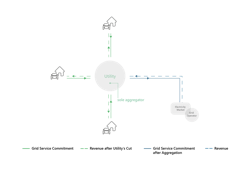The electric vehicle (EV) charging landscape is undergoing significant changes, influenced by policy decisions, technological advancements, and market dynamics. In recent times, Tesla has decided to open its charging standard to the public, which has triggered a domino effect, with major automotive original equipment manufacturers (OEMs), charge point operators, and charger manufacturers in the US embracing North American Charging Standard (NACS). However, there were indications that the Biden administration would enforce the combined charging system (CCS) in the same manner as the European Union did. Such enforcement can have far-reaching implications, especially for industry leader Tesla, as public funding commitments of nearly USD 24 billion through 2030 will then prioritize only the CCS infrastructure.
Regardless, Tesla's vertical integration as an energy company, demonstrated by solar roofs, EV chargers, and advanced platforms, positions it for a significant role in the evolving electricity market, particularly with V2G integration unlocking new revenue opportunities. However, the space for participation and a greater role in the electricity market is reserved and open not only for Tesla but also for automotive OEMs and charge point operators (CPOs) that have adopted NACS. Given the use cases of EV batteries, it is, therefore, safe to predict that V2G integration is the pathway through which players in the V2G space, including automotive OEMs, utilities, and CPOs, will push to tap into the electricity market and revenues it has to offer, which were previously inaccessible.
V2G Scenarios
As we navigate the V2G landscape, three potential scenarios emerge, each with distinctive implications for key stakeholders.
Scenario 1: Automobile OEMs Take the Lead
In the initial scenario, automotive OEMs emerge as exclusive aggregators of EV batteries, holding dominance in the V2G domain. Vertically integrated energy firms, exemplified by Tesla, gain substantial influence by not only offering essential grid services to the utilities through aggregation but also by reducing their revenues with the installation of solar roofs (that provide power back to the grid via V2G-enabled chargers). This poses a significant challenge to vertically integrated utilities, enabling energy companies to negotiate discounted electricity tariffs and potentially limiting the space for companies solely offering electric vehicles and chargers in the V2G space.
Scenario 2: Utilities Assume Aggregation Control
The second scenario envisions utilities taking on the role of the exclusive aggregators of EV batteries, controlling the V2G landscape. This would require convincing regulators that the grid benefits more from utilities as sole aggregators rather than automobile OEMs or CPOs. The likelihood of this scenario is higher in Europe due to market structure and regulatory practices. Generally, if concerns about system security arise with widespread aggregation, regulators are inclined towards utility-centric solutions. While cooperation among utilities, CPOs, and automobile OEMs is essential for aggregation, the predominant share of V2G revenue would belong to utilities in this scenario.
Scenario 3: Charge Point Operators Drive Aggregation
The least likely scenario involves charge point operators (CPOs) acting as exclusive aggregators for electric vehicle batteries, exerting control over the V2G space, and participating in the electricity market for EV owners. This possibility arises if the CPO collaborates with a utility for data sharing, including power systems and public charging data. This collaboration enhances the bidding and forecasting capabilities crucial for effective participation and revenue generation in the electricity market. In this scenario, the other players, for instance, automobile OEMs, may have access to charging data but lack power system data, impacting their forecasting, bidding, and revenue generation through aggregation.
Looking Ahead
Considering the limitations and recognizing that the primary value in vehicle-to-grid (V2G) space will be generated in homes, where the bulk of battery capacity resides, the main competition is expected between utilities and automotive OEMs. While V2G may offer ancillary services with limited influence over utilities in the initial stages, widespread integration with the electricity grid, in the long run, could empower automotive OEMs to negotiate substantial cuts from utility savings. Furthermore, due to the consolidated nature of the automotive industry and its significant lobbying capabilities, it is in a strong position to assume the primary role in the V2G space.
Kamil Maqsood is an Editor at PTR Inc., a United States/Germany-based power grid equipment and infrastructure market research firm. He has a bachelor’s degree in electrical engineering from the University of Engineering and Technology Lahore and a master's in electrical engineering from Lahore University of Management Sciences with a focus on power system planning, electricity markets, power system operations and control, smart grids and battery energy storage systems. He also has experience working with The World Bank (energy team) on electricity distribution sector reforms as a consultant and is part of the research group (funded under the China-Pakistan Economic Corridor) working on Pakistan’s transition to sustainable mobility.
Michael Sheppard (Chief Executive Officer) has 16 years of market research experience designing numerous research practices from scratch while leading over 50 bespoke projects with Fortune 500 companies. In 2016, he co-founded Power Technology Research (PTR) and has since launched new research practices in solar, storage, battery, and e-mobility. In addition to building and growing partnerships, he currently focuses on research around regulation and de-carbonizing efforts. In 2020, he co-founded Matos, an intelligence automation company focused on providing powerful AI-driven tools for the market research sector. In 2023, this business was acquired by PTR. Prior to founding PTR, he spent eight years with iSuppli/IHS Markit in various analyst and consulting roles, where he covered a broad range of sectors, including mobile, renewable power, and electricity transmission and distribution (T&D). In his last role, he led the power technology consulting group. He is an expert on the PV industry and has performed numerous competitive dynamics and opportunity assessment projects, covering upstream, downstream, and supply chain topics. In 2008, he obtained a Bachelor of Science in both Financial Services and Corporate Finance from San Francisco State University.
Hassan Zaheer is the chief operating officer at PTR Inc. based in Abu Dhabi, UAE. With more than a decade of experience in the energy transition space, Hassan works for various Fortune-500 blue-chip clients on global market studies in the electrical infrastructure sector. In his current role at PTR, he works with clients to sustainably grow their businesses, both through custom consulting work and tailored research reports by PTR, helping their executive management and boards make data-driven decisions. Hassan is also a Member of the Advisory Board for CWIEME Berlin and an advisor to the educational non-profit Better Humans Academy. Hassan has a tech background with a Master's in Power Engineering from the Technical University of Munich (TUM) and a BS in Electrical Engineering from the Lahore University of Management Sciences (LUMS). Additionally, he is also an alumnus of the Center for Digital Technology & Management (CDTM).
Saqib Saeed is a highly accomplished market research professional and a data storyteller in the international energy industry. With over a decade of experience in the field, he currently serves as the Chief Product Officer at PTR Inc. His expertise lies in the power grid and e-mobility equipment sectors. Throughout his career, Saqib has overseen numerous global market research studies and provided valuable insights to key decision-makers at various Fortune 500 companies. He is a member of the editorial board for Transformers Magazine and a member of the Advisory board of CWIEME Berlin. In addition to his market research career, Saqib has also worked in the manufacturing sector. Saqib holds a Master's degree in Electrical Power Engineering from the Technical University of Munich.





